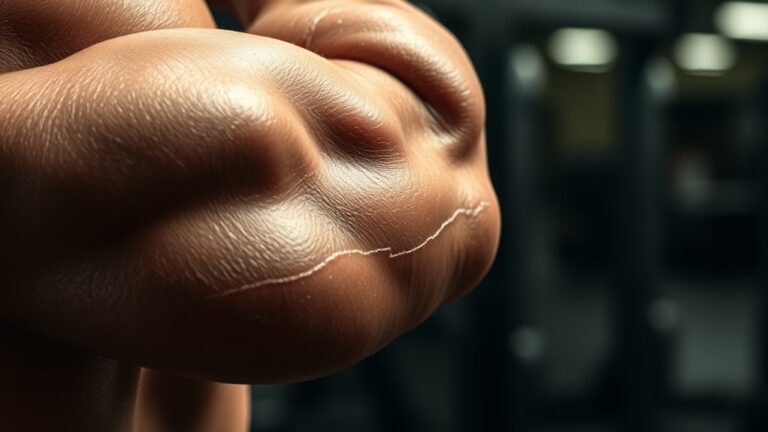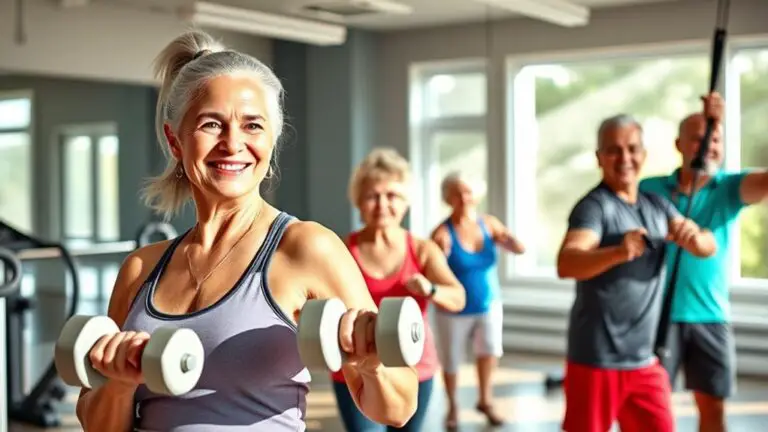Best Gym Workouts for Teenagers
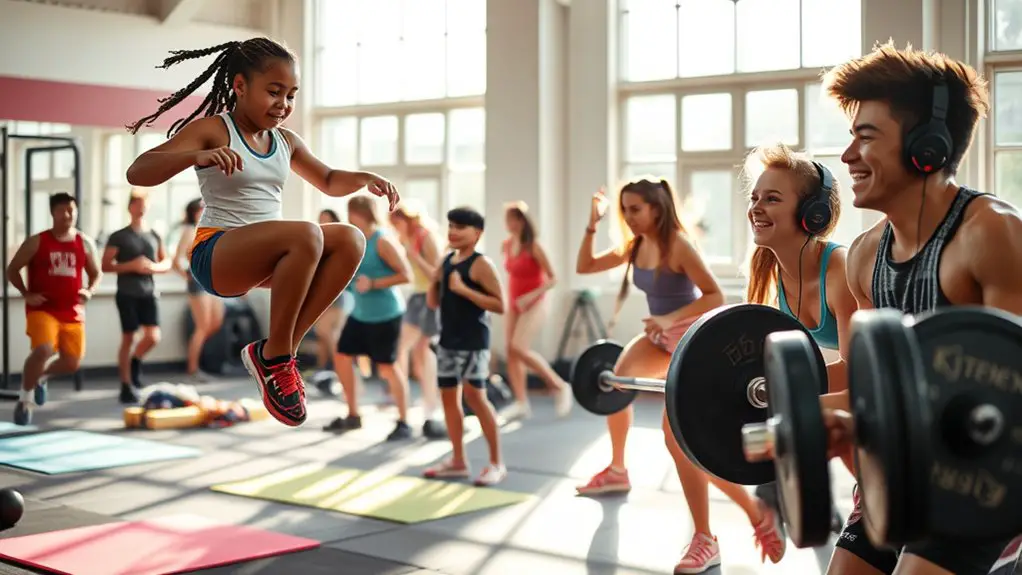
For the best gym workouts as a teenager, focus on full-body exercises like squats and push-ups to build strength, along with cardio sessions like running or cycling to boost endurance. Set realistic goals and gradually increase intensity to prevent injuries. Engage in group workouts for motivation and community support. Don’t forget to include flexibility and mobility exercises for overall wellness. Continue to explore more about effective recovery techniques and how to set goals that keep you on track.
Importance of Fitness for Teens
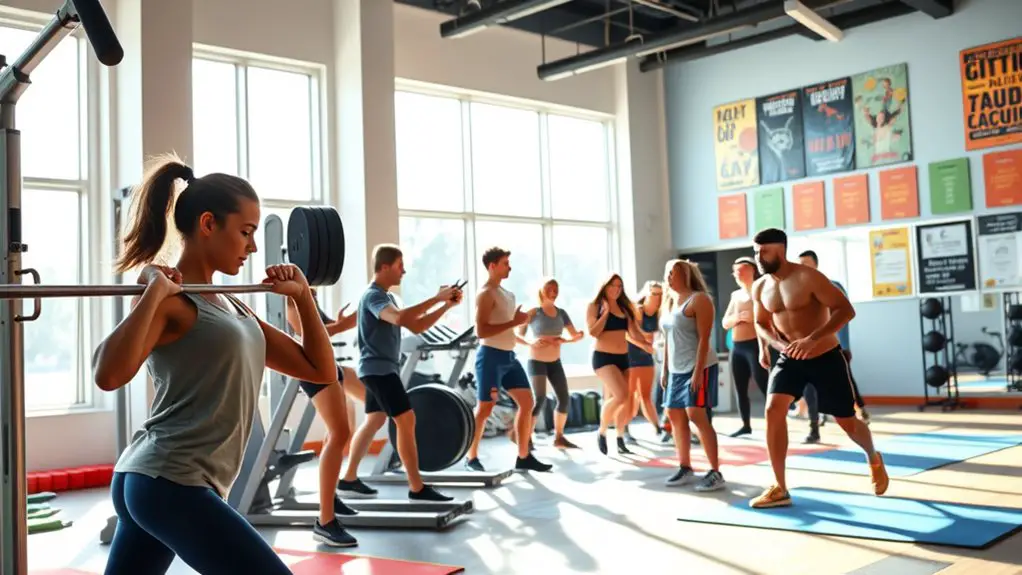
Fitness is essential for teenagers, as it lays the foundation for a healthy lifestyle. Regular physical activity not only strengthens your body but also greatly boosts your mental health. You may not realize it, but exercise releases endorphins, which can help reduce stress and anxiety. This sense of well-being can enhance your overall mood, making it easier to handle the ups and downs of teenage life.
Moreover, engaging in fitness activities often promotes social interaction. Whether you’re joining a sports team or hitting the gym with friends, these experiences allow you to connect with others, fostering a sense of community and belonging. This social aspect is vital during your teenage years, as it can improve your self-esteem and confidence. Additionally, regular exercise reduces the risk of chronic diseases that can affect your health in the long run. So, by prioritizing fitness, you’re not just working on your physical strength; you’re also nurturing your mental health and building valuable relationships that can last a lifetime.
Getting Started: Tips for Beginners
Getting started with gym workouts can be exciting, but it’s important to set realistic goals that match your fitness level. You’ll also want to focus on learning proper techniques to avoid injuries and get the most out of your workouts. With the right approach, you’ll build a solid foundation for your fitness journey. Additionally, remember to listen to your body to prevent injuries and ensure a sustainable workout routine.
Set Realistic Goals
While it might be tempting to jump into an intense workout regimen, setting realistic goals is essential for long-term success and motivation. When starting your fitness journey, it’s vital to have realistic expectations to avoid burnout or injury. Here are some tips to help you set achievable goals:
- Start with small, specific targets, like working out twice a week.
- Focus on gradual progress, such as adding five more minutes to your cardio sessions each week.
- Keep your personal motivation in mind, whether it’s improving your health or building strength.
Learn Proper Techniques
Achieving your fitness goals starts with learning proper techniques, especially for beginners. Understanding proper form is essential to guarantee exercise safety and avoid injuries. Here’s a quick guide to help you focus on key movements and safety tips:
| Exercise | Key Technique |
|---|---|
| Squats | Keep your back straight, knees behind toes |
| Push-ups | Maintain a straight line from head to heels |
| Deadlifts | Hinge at your hips, keep the bar close to your body |
| Lunges | Step forward, making sure your front knee doesn’t extend past your toes |
Take the time to practice these movements. Don’t hesitate to ask a trainer for help if you’re unsure. Mastering proper techniques sets a strong foundation for your fitness journey.
Full-Body Workouts for Overall Strength
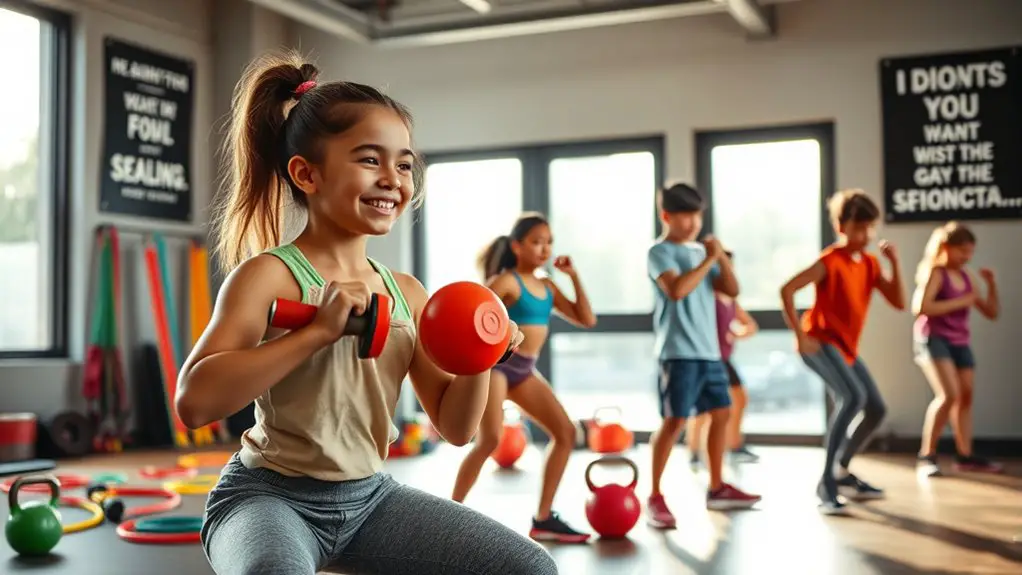
If you want to build overall strength, incorporating full-body workouts into your routine is crucial. These workouts engage multiple muscle groups and improve your functional fitness. Here are some effective strategies to take into account:
- Focus on compound exercises: Movements like squats, deadlifts, and bench presses work several muscles at once, maximizing your strength gains.
- Integrate bodyweight training: Exercises such as push-ups, pull-ups, and planks can be done anywhere and help improve your stability and endurance.
- Balance your routine: Verify you include both upper and lower body workouts to prevent muscle imbalances and reduce the risk of injury.
Incorporating goblet squats can also be a beneficial alternative to traditional squats for overall strength development. Always prioritize proper form over heavy weights to keep yourself safe. As you progress, you can gradually increase the intensity. Full-body workouts are a great way to develop strength while building a solid foundation for your fitness journey.
Cardio Workouts to Boost Endurance
Cardio workouts aren’t just about burning calories; they’re key to boosting your endurance for sports and daily activities. You’ll discover how effective exercises can elevate your stamina and overall fitness. Let’s explore the benefits of cardio training and some great workouts to get you started. Incorporating activities like jump roping can significantly enhance cardiovascular health and coordination.
Benefits of Cardio Training
While many teenagers focus on strength training, incorporating cardio workouts can greatly boost your endurance and overall fitness. Cardio isn’t just about running or cycling; it offers several benefits that can enhance your workouts and daily life:
- Improved heart health: Regular cardio strengthens your heart, making it more efficient at pumping blood.
- Enhanced mental clarity: Engaging in cardio can help clear your mind, improving focus and concentration during school and activities.
- Increased stamina: With consistent cardio training, you’ll find it easier to perform daily tasks and sports without feeling fatigued.
Remember to choose activities that you enjoy and listen to your body. Staying safe and having fun should always be your priority when exploring cardio workouts!
Effective Cardio Exercises
Finding the right cardio exercises can make all the difference in boosting your endurance and overall fitness. High intensity interval training (HIIT) is a fantastic option; it alternates short bursts of intense activity with rest periods, helping you build stamina without lengthy workouts. You can do HIIT with exercises like burpees, jumping jacks, or sprints.
Outdoor running is another excellent choice. It not only improves your cardiovascular health but also offers fresh air and varied terrain to keep things interesting. Remember to wear proper shoes and stay hydrated. Start with a comfortable pace, gradually increasing your distance and speed as your endurance improves. Always listen to your body, and don’t push yourself too hard to avoid injuries. Happy exercising!
Strength Training Basics for Teens
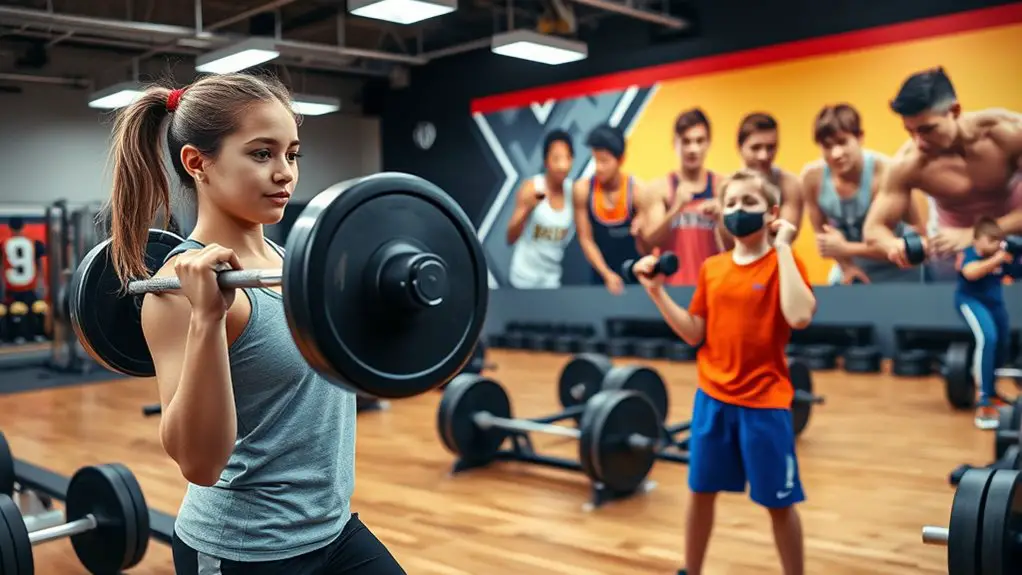
Strength training can be a fantastic way for teens to build muscle, improve athletic performance, and boost confidence. Starting with safe and effective methods is vital. Here are some basics to take into account:
- Bodyweight exercises: Push-ups, squats, and lunges are great ways to start. They use your body weight for resistance, minimizing injury risk.
- Resistance bands: These bands provide adjustable resistance and can be used for various exercises, making them perfect for beginners.
- Proper form: Always focus on technique. Good form prevents injuries and guarantees you’re working the right muscles.
Before starting any strength training program, it’s essential to consult with a coach or trainer. They can help create a plan tailored to your goals and guarantee your safety. Remember, it’s not just about lifting weights; it’s about building a strong foundation for your fitness journey! Additionally, having the right gym clothes helps ensure comfort and performance during workouts.
Fun Group Workouts to Stay Motivated
When you’re part of a group workout, the energy and camaraderie can make exercising feel less like a chore and more like a fun activity. Engaging in team challenges can boost your motivation, as you’ll be working alongside friends who encourage you to push your limits. The group dynamics foster a sense of belonging, enhancing your workout experience.
You might try competitive workouts like circuit training or relay races that keep things exciting and promote social motivation. Plus, these fun activities contribute to a strong community spirit, making you feel connected to others with similar fitness goals. Always remember to prioritize safety; make certain you’re using proper form and listening to your body. Incorporating activities like skipping rope can also enhance your cardio workout, making it an excellent addition to your group sessions. With the right group, staying active becomes a rewarding part of your routine, keeping you motivated while building friendships along the way. Embrace the fun and let the community support you on your fitness journey!
Flexibility and Mobility Exercises
Incorporating flexibility and mobility exercises into your routine is essential for overall fitness, especially for teenagers whose bodies are still developing. These exercises help improve your range of motion, prevent injuries, and enhance athletic performance.
Here are some effective options to evaluate:
- Dynamic stretches: These are great for warming up your muscles and preparing your body for activity. Think leg swings, arm circles, and walking lunges.
- Mobility drills: Focus on moving your joints through their full range of motion. Exercises like hip openers and shoulder dislocates can be incredibly beneficial.
- Cool-down routines: After your workouts, include stretches that promote flexibility and relaxation, such as seated forward bends and butterfly stretches.
Workout Recovery: Importance and Techniques
Although many teenagers focus on building strength and endurance, workout recovery is just as essential for overall performance and health. Incorporating techniques like active recovery and effective hydration strategies can greatly enhance your recovery process.
| Recovery Technique | Description | Benefits |
|---|---|---|
| Active Recovery | Light exercises post-workout | Reduces soreness, increases blood flow |
| Hydration Strategies | Drinking water and electrolytes | Aids muscle recovery, prevents dehydration |
| Stretching | Gentle stretching routines | Improves flexibility, decreases injury risk |
| Sleep | Prioritizing quality rest | Boosts recovery, enhances performance |
Prioritizing recovery helps your muscles rebuild and prepares you for your next workout. Make sure to listen to your body; if you’re feeling fatigued, don’t hesitate to take a break or opt for lighter activities. Waiting at least 30 minutes after activities like massage therapy can also be beneficial for optimal recovery. Your future self will thank you!
Setting and Achieving Fitness Goals
Recovering from your workouts sets the stage for your next fitness journey—one that clearly defines your aspirations. Setting achievable fitness goals is essential for staying motivated and tracking your progress safely. Here are some effective goal-setting strategies to help you succeed:
- SMART Goals: Make your goals Specific, Measurable, Achievable, Relevant, and Time-bound.
- Break It Down: Divide larger goals into smaller, manageable steps to keep you focused.
- Stay Flexible: Adjust your goals as needed; life can throw unexpected challenges your way.
Frequently Asked Questions
How Often Should Teenagers Work Out Each Week?
When considering how often you should work out each week, aim for about three to five days. This workout frequency allows your body to gain strength and endurance while minimizing the risk of injury. Incorporating a mix of cardio and strength training can amplify exercise benefits, like improved mood and better overall health. Remember to listen to your body and rest when needed; safety should always come first in your fitness journey.
What Equipment Is Essential for a Home Workout?
When setting up your home gym, there are a few workout essentials you shouldn’t overlook. Start with a sturdy mat for floor exercises and stretching. Resistance bands are great for strength training while being safe and versatile. A set of dumbbells can help you build muscle effectively. Don’t forget a stability ball for core workouts. Always prioritize safety by ensuring your equipment is in good condition and suitable for your fitness level.
Can Teenagers Lift Weights Safely?
Yes, teenagers can lift weights safely if they follow proper techniques and guidelines. Weightlifting offers numerous benefits, including improved strength, endurance, and confidence. To guarantee injury prevention, start with lighter weights and focus on form. Gradually increase the weight as you gain experience and strength. It’s also wise to have supervision or guidance from a knowledgeable trainer. Remember, safety first—listen to your body, and don’t push beyond your limits.
What Should Teens Eat Before and After Workouts?
Imagine you’re a car, and the fuel you choose determines how well you run. Before a workout, you need pre workout snacks like a banana or a small yogurt to rev up your engine. After you’ve hit the road, your post workout meals should be a mix of protein and carbs, like grilled chicken with rice, to refuel and repair. With the right fuel, you’ll safely power through your fitness journey.
How Can Teens Stay Motivated to Exercise Regularly?
Staying motivated to exercise regularly can be tough, but you can make it easier. Start by setting clear, achievable goals that excite you. Whether it’s improving your strength or running a certain distance, having a target keeps you focused. Also, consider teaming up with workout buddies. Exercising with friends not only makes it more fun but also holds you accountable. Remember, safety first—always listen to your body and don’t push too hard.




